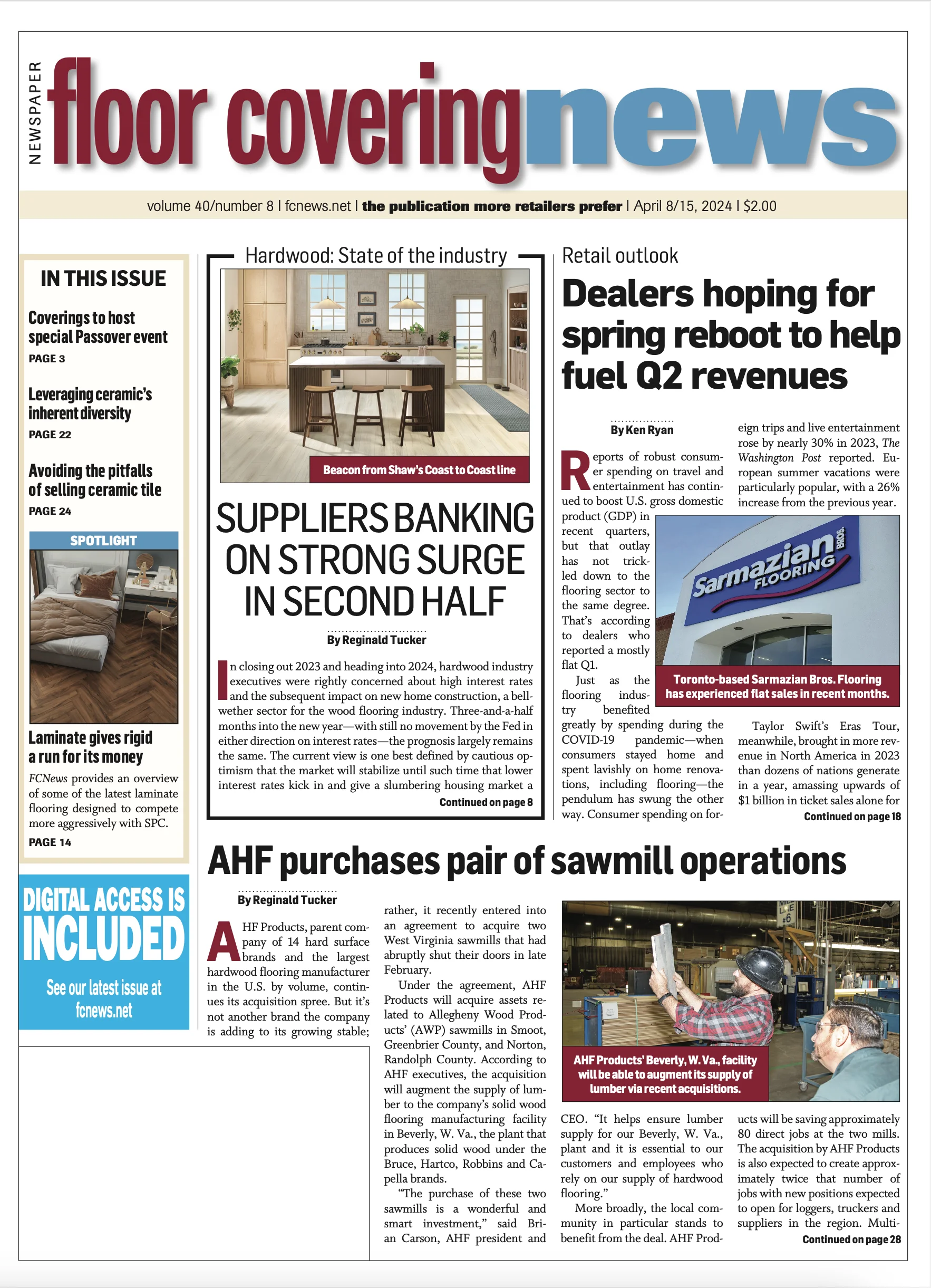![]() In closing out 2023 and heading into 2024, hardwood industry executives were rightly concerned about high interest rates and the subsequent impact on new home construction, a bellwether sector for the wood flooring industry. Three-and-a-half months into the new year—with still no movement by the Fed in either direction on interest rates—the prognosis largely remains the same. The current view is one best defined by cautious optimism that the market will stabilize until such time that lower interest rates kick in and give a slumbering housing market a much-needed wake-up slap.
In closing out 2023 and heading into 2024, hardwood industry executives were rightly concerned about high interest rates and the subsequent impact on new home construction, a bellwether sector for the wood flooring industry. Three-and-a-half months into the new year—with still no movement by the Fed in either direction on interest rates—the prognosis largely remains the same. The current view is one best defined by cautious optimism that the market will stabilize until such time that lower interest rates kick in and give a slumbering housing market a much-needed wake-up slap.
“High interest rates and high home pricing is serving as a bit of a ‘wet blanket’ on the over- all housing market—both new construction and existing home turnover,” said Dan Natkin, chief commercial officer for Bauwerk Group, parent company of the Boen and Somerset hardwood brands. “We are also seeing some trade down as builders look to control costs as well as smaller home sizing, thereby limiting total floor area for hard- wood flooring. Consumers with low interest rate mortgages are generally stuck in their homes, leading to low home turnover. In the long run we believe this will spark increased remodel demand, but as of right now we are not seeing it.”
For some hardwood flooring industry executives, it’s a “good news/bad news” situation. “Quite frankly, I thought we would be looking at our first interest rate lowering in the April timeframe, but that’s clearly not going to happen—that’s the bad news,” said Brian Carson, president and CEO of AHF Products, the industry’s largest wood flooring manufacturer by volume.
The “good” news, he said, is ultimately the market will wind up in essentially the same situation (rate wise) that experts predicted for 2024 at the end of 2023. “I think we still may have two to three interest rate cuts versus four to five interest rate cuts for the year. That means those rate decreases are likely going to happen much later this year and extend into early next year.”
If that prediction comes to fruition, Carson noted, it will spark activity in the new home construction market—particularly the single-family home sector. “The builder business for AHF Products is strong, we can see it in the home sales,” he explained. “And I think it’s strong in part because of the lack of availability of existing homes, so people are building new. That’s a bright spot for the hardwood business, as we all know there’s a fair amount of wood used in new construction.”
Kyle McAllister, director of hardwood, Shaw, said he is seeing new home starts begin to pick up again, following a slow start to the new year. Like many industry observers, he expects the wood flooring segment will ultimately benefit in the back half of the year depending on typical movements seen in housing cycles. But, again, much depends on interest rates.
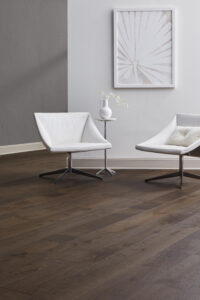 “By this time of the year, we thought we would see stronger signals from the Fed that interest rates would start ticking down, but it looks like we’re going to have to wait a little bit longer on that,” he said. “Rates might go down a little bit, but I don’t think we’ll ever see that 2.9%, 2.8% rate of inflation anytime soon. If you have a mortgage at 3.25% and you’re looking to move, nobody wants to go from 3.25% to a 7%-7.5%.”
“By this time of the year, we thought we would see stronger signals from the Fed that interest rates would start ticking down, but it looks like we’re going to have to wait a little bit longer on that,” he said. “Rates might go down a little bit, but I don’t think we’ll ever see that 2.9%, 2.8% rate of inflation anytime soon. If you have a mortgage at 3.25% and you’re looking to move, nobody wants to go from 3.25% to a 7%-7.5%.”
It’s not only stubbornly high interest rates that stand to im- pact the hardwood market this year. Executives cite a number of other mitigating factors. “We are also in a very interesting election year, and we have also seen a large number of layoffs from major companies in Q1,” said Sean Brennan, president, Kährs Americas. “This, coupled with high rates, will continue to prove to be a challenge for not only new home construction but the economy as a whole.”
While all this plays out, suppliers are waiting with anticipation of what’s to come. “We’re sitting on pins and needles,” said David Moore, senior product director, Mohawk. “The interest rate movement is going to be such a critical, important piece to unlocking what’s going on in builder. We’re all anticipating some positivity in Q3 and Q4 based on anticipated changes, but we really just have to see what the Fed is going to do. Even just a couple of percentage points down is really going to unlock the builder market.”
One of the main challenges facing hardwood in the builder market right now, according to Moore, is the fact that many builders are looking to take costs out of the equation. Problem is, hardwood is one of the more expensive options that can go into a new build. “In new home construction, especially single-family, it’s such a competitive landscape right now with the rates we’re seeing,” he explained. “That’s creating headwinds for hardwood, since it is one of the more premium and high average selling price per-square-foot products in the market. However, if the market unlocks and we start seeing a ton of building and new construction, that’s obviously going to carry engineered hardwood with it and create more of a tailwind.”
That’s precisely what many suppliers are banking on. For Paul Rezuke, vice president of sales, U.S., the outlook is still promising despite some uncertainty. In anticipation of an eventual upswing down the road, the company is planning accordingly so it might reap the benefits when the market rebounds.
“We have aligned our products with some new customers,” he said. “Along with the two to three anticipated interest rate cuts, that should serve as a boost for us going forward.”
Others, including David Lauzon Jr., director of sales, Lauzon Hardwood, are equally optimistic about the prospects of a projected turnaround. “The first part of the year was slower than we initially forecasted, largely due to high interest rates,” he said. “However, since the end of February, we have observed some positive developments and increased activity across most of the USA. Our products, primarily installed in single-family residences, have experienced a more optimistic outlook in terms of new home starts compared to the multifamily sector. We are hopeful that a continued decrease in interest rates will further encourage growth in new home construction.”
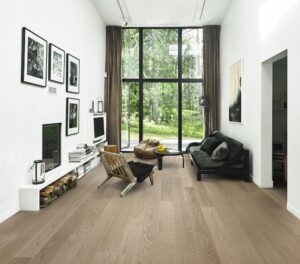 For Mirage Hardwood, another major Canadian player with strong ties to the U.S. market, the mood is upbeat but measured. “We, like many others, anticipate that the current interest rate stability will not persist excessively, fostering increased market activity in Q3 and Q4,” said Jerome Goulet, director of marketing. “Looking further ahead, the market’s historical ebbs and flows remind us of the enduring nature of real estate, where patience inevitably yields results.”
For Mirage Hardwood, another major Canadian player with strong ties to the U.S. market, the mood is upbeat but measured. “We, like many others, anticipate that the current interest rate stability will not persist excessively, fostering increased market activity in Q3 and Q4,” said Jerome Goulet, director of marketing. “Looking further ahead, the market’s historical ebbs and flows remind us of the enduring nature of real estate, where patience inevitably yields results.”
Others are also playing the long game. “At Kährs, we are not slowing down,” Brennan noted. “We are continuing to invest in our sales teams, new products and ongoing innovation.”
Eye on residential remodel
While industry observers keep their fingers on the pulse of the new home construction market, they are also tracking activity in the residential remodel sector. Residential remodel certainly experienced a surge in activity during the pandemic and the ensuing years as more consumers opted to refurbish their spaces instead of spending money on vacations, entertainment, leisure and dining out, etc.
While this segment has typically been a stronghold for hardwood flooring sales—accounting for anywhere between 60%-65% of revenues in 2023—those competing sectors, as well as heavy marketing by the automotive manufacturers, are increasingly vying for more of consumers’ disposable dollars.
“The pandemic provided an incredible demand for residential replacement, but that has since changed,” Wickham’s Rezuke stated. “Following a span where most people focused on upgrading and sprucing up the family homes, vacations and other luxuries are more significant. We are seeing a return to pre-COVID-19 use of disposable dollars.”
Pat Oakley, president, Mullican Flooring, agreed. “Looking back over the pandemic, a lot of residential remodels—a lot of projects in general, in fact— were pulled forward. Then, about mid-2022, as we emerged from the lockdowns and the COVID-19 effect on the country, you saw people rotate out of home projects and into travel, leisure, vacations—those types of things. That has put a lot of these remodeling projects on the back burner.”
On the back burner, for some, but definitely not off the kitchen table altogether. “While we are seeing an increase in other purchases such as travel, vehicles, etc., the residential replacement sector is holding its own,” said Renee Tester, director of marketing at Kährs Americas. “Homeowners see the value in creating equity within their homes and how this investment is one that they can reap benefits from. Projects are smaller now, and consumers are not in a major hurry to complete a job due to supply or labor issues.”
Peeling back the layers of the proverbial onion, suppliers are seeing greater consumption of upper-middle to high-end hardwood products. At AHF Products, for example, it’s the tale of two worlds. As Milton Goodwin, the company’s vice president, explained: “It all depends on where you are. If you’re in the Southwest, that’s predominantly a 3/8-inch market. We’ve had some good success with some new launches at that level, but our biggest growth has been more on the higher end. People who have the money are spending it on higher-end products.”
Moreover, consumers looking to complete their remodeling projects are looking for products that offer greater value. “It is certainly true that larger shares of disposable incomes are directed more toward service spends,” said Sam Kim, senior vice president, MSI. “That said, while the general demand for flooring has softened, the demand for flooring with compelling value propositions continues to see strong consumer demand, in part due to the renewable aspect of its composition.”
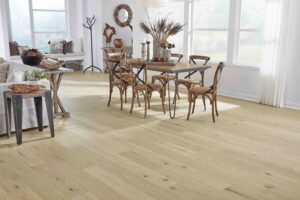 Competition from rigid core
Competition from rigid core
An ongoing challenge facing the hardwood flooring segment is competition from wood lookalike categories such as SPC and laminate. Despite the inherent advantages that hardwood offers with respect to the resale value of a home, wood has ceded share to rigid core—and even laminate— the past few years. The task now facing hardwood suppliers, some of whom also offer competing hard surface products, is clawing back some of that lost share.
“There’s a lot of fatigue out there with SPC,” said Brian Parker, vice president of product management, AHF Products. “Obviously, the rigid category took huge market share and the product has reared its head with some issues in the marketplace. But through it all, the one thing that remains steady is the value and the desire of wood flooring in a home. So, our job is to make sure we’re providing beautiful products that are going to stand the test of time. It’s the only product, really, that goes into a home that’s considered a forever floor.”
Shaw, a major hardwood supplier that also participates heavily in the resilient category, is also acutely aware of the in-fighting between the dueling product segments. “We’re the 800-pound gorilla in the room when it comes to resilient flooring,” McAllister said, citing Shaw’s investment in domestic resilient production. “We have a very successful, resilient business and we love that business. It’s a lucrative business. We just have to make sure that we’re establishing a strategy for all categories that are going to benefit the enterprise.”
Part of that strategy for Shaw entails segmenting the various categories in which the company plays. “So many SPC/WPC products are configured and designed to look like hardwood, so naturally that’s nipping share from the wood segment,” McAllister added. “But we’ve also seen some pullback from entry-level, low-quality SPC and a pivot now to laminate for some retailers. The important thing to remember is the consumer who wants real hardwood is aware of all the benefits, and they’re going in specifically for that. So the chances of an RSA shifting somebody walking in with let’s say a $15,000 hardwood budget down to a $5,000 wood look or wood imitation product are slim.” Boen’s Natkin agreed whole- heartedly. “We have seen degradation in demand at the lowest ends of hardwood; conversely, the upper end is holding up nicely. For consumers who really want wood, they are selecting looks and formats not matched by the ‘wannabe’ products.”
At the end of the day, preserving hardwood flooring’s share hinges on educating retail sales associates about the unique value proposition hardwood offers. As Lauzon of Lauzon Hardwood explained: “Hardwood flooring is a classic and timeless choice for homes, prized for its natural beauty, durability and longevity. It not only adds significant value to a property, enhancing its resale potential, but it also offers aesthetic and practical benefits. Moreover, hardwood flooring is the most environmentally friendly option available. Unlike some alternatives that may contain harmful chemicals or non-biodegradable materials, genuine hardwood is a natural and renewable resource.”
Despite those well intentions, Lauzon says uneducated homeowners are being fooled into purchasing non-biodegradable, petroleum-based products that mimic the appearance of wood. “These products can have negative environmental impacts and may not offer the same level of durability or beauty as genuine hardwood flooring,” he explained. “Unfortunately, homeowners often realize these drawbacks only after making their purchase.”
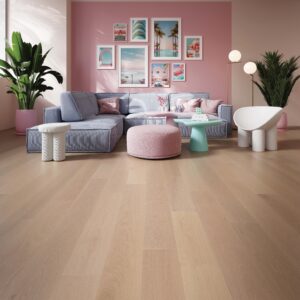 Raw materials situation
Raw materials situation
Another issue hardwood flooring suppliers continue to grapple with is the demand for popular species such as European white oak. Desired for its aesthetic attributes and performance qualities, white oak has caused pricing pressures due to the high demand compared to its fairly limited supply. It’s a delicate dance that suppliers have had to orchestrate to help manage production costs while meeting consumer expectations.
“The forest is only going to give you a 30% white oak; the other 70% is red oak,” AHF Products’ Parker explained. “Those trees get used in primarily three different segments. The high grade goes into furniture and cabinets and case goods, and those markets aren’t using as much white oak anymore. So, less is being harvested because the mills can’t sell that premium wood at a high price like they used to. Flooring’s there in the middle tier, and then railroad ties in the lower tier.”
Those are not the only manufacturing segments competing for hardwood. “You’ve got the bourbon barrel and the whiskey barrel manufacturers who are taking more than their share—they can pay more for it than we can sell it for, and so that’s driven us and others to look for alternate solutions,” Parker added.
Suppliers, regardless of their home base of operation, attest to how the hardwood lumber market is being influenced by demand from unrelated product segments. “This diversified demand is putting additional pressure on the lumber supply, thereby impacting pricing not just for the hardwood flooring sector but across multiple industries that rely on these raw materials,” Lauzon said. “The compounded effect of increased global demand across various sectors and the slowed production capabilities may lead to significant price volatility and supply constraints in the near future.”
The industry faced a similar situation in the immediate aftermath of Russia’s invasion of Ukraine. The war put a halt to imports of Baltic Birch, a species commonly used in the core level of many engineered products.
“Sourcing of the right lumber has become more challenging, especially in light of the ban on Russian timber,” MSI’s Kim explained. “It is very important that customers work with brands that have rigorous tracking and auditing processes in place to ensure the flooring products they are purchasing from are Lacey Act compliant.”
The key, experts say, lies in being diversified in one’s sourcing strategies. “A large percentage of our hardwood products are European white oak, and due to our longstanding partnerships, we have been able to be consistent with our supply and pricing,” Kährs’ Tester stated. “We are seeing some species, such as maple and hickory that are growing in popularity, and we are working to expand this assortment by summer of this year. This increase will allow room for growth with other species.”
For the time being, though, there doesn’t appear to be any cause for alarm. “There’s a lot less volatility than we’ve seen in the past couple of years; things are really calming down,” Mohawk’s Moore stated. “A large portion of our portfolio is manufactured outside of the United States, so we are somewhat isolated from some of those issues. I think the biggest variability when you have a portfolio like that is in transportation costs, which have definitely stabilized and returned to pre-pandemic rates.”

